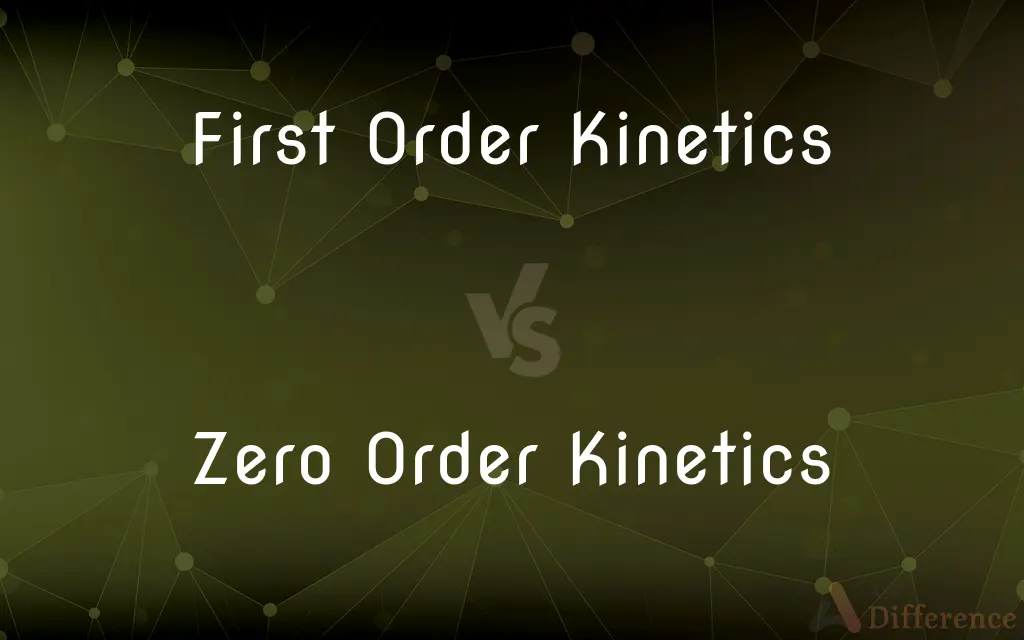First Order Kinetics vs. Zero Order Kinetics — What's the Difference?
Edited by Tayyaba Rehman — By Fiza Rafique — Published on December 9, 2023
First Order Kinetics depends on the concentration of one reactant, with the rate decreasing over time. Zero Order Kinetics has a constant rate, independent of the reactant's concentration.

Difference Between First Order Kinetics and Zero Order Kinetics
Table of Contents
ADVERTISEMENT
Key Differences
First Order Kinetics and Zero Order Kinetics are fundamental concepts in chemical kinetics, describing how the rate of a reaction varies with time. First Order Kinetics is characterized by a rate that is proportional to the concentration of one reactant. In contrast, Zero Order Kinetics exhibits a rate that remains constant, irrespective of the reactant's concentration.
In First Order Kinetics, as the reaction progresses, the rate decreases due to the diminishing concentration of the reactant. With Zero Order Kinetics, the rate of the reaction doesn't change over time, remaining the same from the beginning to the end.
When plotting concentration against time, First Order Kinetics yields a non-linear curve, representing the decreasing rate of the reaction. Zero Order Kinetics, on the other hand, gives a straight line, symbolizing a consistent rate of reaction.
Mathematical expressions for these kinetics also differ. The rate equation for First Order Kinetics is expressed as rate = k[A], where k is the rate constant and [A] is the concentration of the reactant. For Zero Order Kinetics, it's rate = k, indicating the rate's independence from reactant concentration.
Enzyme-catalyzed reactions provide practical examples. In some cases, enzymes follow First Order Kinetics when substrate concentration is low. However, when the enzyme is saturated with substrate, the reaction often exhibits Zero Order Kinetics.
ADVERTISEMENT
Comparison Chart
Rate Dependency
Proportional to the concentration of one reactant
Constant, independent of reactant concentration
Rate Change
Decreases as reactant concentration diminishes
Remains the same throughout the reaction
Graphical Representation
Non-linear curve
Straight line
Rate Equation
Rate = k[A]
Rate = k
Example
Certain enzyme-catalyzed reactions at low substrate concentrations
Enzyme-catalyzed reactions at high substrate concentrations
Compare with Definitions
First Order Kinetics
Exhibits a non-linear concentration-time curve.
Graphing First Order Kinetics reveals a curve, indicating a changing rate.
Zero Order Kinetics
Rate remains constant.
Regardless of how much reactant is present, Zero Order Kinetics maintains a steady rate.
First Order Kinetics
Rate proportional to reactant concentration.
In First Order Kinetics, as the reactant is consumed, the reaction slows down.
Zero Order Kinetics
Observed in saturated enzyme reactions.
When enzymes are fully loaded with substrate, they often follow Zero Order Kinetics.
First Order Kinetics
Common in certain enzyme-substrate reactions.
At low substrate levels, many enzymes exhibit First Order Kinetics.
Zero Order Kinetics
Represented by rate = k.
The simplicity of the Zero Order Kinetics equation shows its independence from concentration.
First Order Kinetics
Represented by rate = k[A].
The mathematical model for First Order Kinetics directly involves the reactant's concentration.
Zero Order Kinetics
Exhibits a straight concentration-time graph.
A straight line on the graph represents the consistency of Zero Order Kinetics.
First Order Kinetics
Rate changes due to decreasing reactant.
The essence of First Order Kinetics is the diminishing speed as the reaction progresses.
Zero Order Kinetics
Rate is independent of reactant concentration.
In Zero Order Kinetics, whether there's a lot or a little reactant, the rate remains unchanged.
Common Curiosities
How does the rate of a reaction in First Order Kinetics change over time?
It decreases as the concentration of the reactant diminishes.
Which kinetics, when graphed, yields a straight line?
Zero Order Kinetics.
How is the rate equation for First Order Kinetics expressed?
As rate = k[A].
What's the key distinction between First Order Kinetics and Zero Order Kinetics?
First Order Kinetics is proportional to reactant concentration, while Zero Order Kinetics has a constant rate.
What kind of curve does First Order Kinetics produce on a graph?
A non-linear curve.
Why is the rate constant in Zero Order Kinetics?
Because it's independent of the concentration of the reactant.
Can a reaction switch between First and Zero Order Kinetics?
Yes, especially in enzyme-catalyzed reactions based on substrate concentration.
Which kinetics is observed when an enzyme is saturated with substrate?
Zero Order Kinetics.
Are all reactions either First Order or Zero Order?
No, there are also second order and other higher-order kinetics.
What happens in First Order Kinetics when the reactant is entirely consumed?
The rate of the reaction becomes zero.
Share Your Discovery

Previous Comparison
Grana vs. Thylakoid
Next Comparison
Plunderer vs. PillagerAuthor Spotlight
Written by
Fiza RafiqueFiza Rafique is a skilled content writer at AskDifference.com, where she meticulously refines and enhances written pieces. Drawing from her vast editorial expertise, Fiza ensures clarity, accuracy, and precision in every article. Passionate about language, she continually seeks to elevate the quality of content for readers worldwide.
Edited by
Tayyaba RehmanTayyaba Rehman is a distinguished writer, currently serving as a primary contributor to askdifference.com. As a researcher in semantics and etymology, Tayyaba's passion for the complexity of languages and their distinctions has found a perfect home on the platform. Tayyaba delves into the intricacies of language, distinguishing between commonly confused words and phrases, thereby providing clarity for readers worldwide.
















































